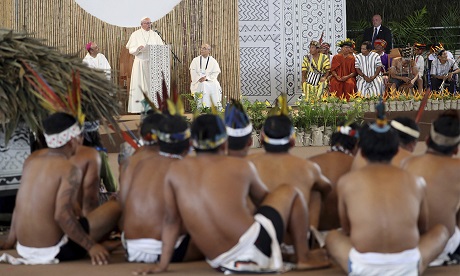One proposal at the Pan-Amazon Synod is for indigenous- or Amazonian-rite ceremonies to be used to enhance and enrich the liturgy.
Cultural signs and gestures could be incorporated into the liturgy without changing what is essential for Catholics, bishops say.
Bishop Rafael Escudero Lopez-Brea of Peru, says this suggestion isn’t about Catholics asking for a new “liturgical rite”.
The essential elements “received by the Lord and the apostles in the Eucharist” would be retained, while introducing cultural elements.
“When we speak of this possibility, it means to introduce some symbols into the Eucharist, some rites that do not affect what is essential in the Eucharist because if not, we would ruin the sacrament and go against that revelation,” Escudero says.
He was one of several participants who addressed the theme of inculturation to “open the church to discover new paths within the rich diversity of Amazonian culture”.
Escudero says incorporating local traditions and cultural elements can already be seen in Eastern Catholic churches and Latin-rite Masses in Africa.
“If we study church history, we can see that before everything was unified under the Roman rite, a multiplicity of different rites existed according to the area,” he says.
Bishop Eugenio Coter of Bolivia says certain symbols and gestures used in the Latin rite can have entirely different meanings depending on the country or culture.
“A bishop told me that a change was asked for the liturgy in Japan”.
Coter says the change was requested because in Japan the gesture of beating one’s chest is a gesture of pride, of affirmation, as if saying “I matter”.
Therefore, “placing it during the ‘Confiteor’ has an entirely different meaning. An adaptation must be made,” Coter says.
Another example Coter offers is about the use of incense during Mass.
He says for some indigenous groups in the Amazon, the use of incense, which “is a sign of God’s presence” in the Latin rite, signifies prayers rising to God in heaven.
With indigenous Catholics, “incense is used during the prayers of the faithful”, where the reader sprinkles the incense to show that “the prayer rises to heaven”.
Coter says he supports the idea of setting up a commission of experts who can recommend ways to incorporate into the Eucharist “the language, signs, gestures, music and local culture of every ethnic group while safeguarding that which the word of God and faith tells us.
“That is why there are structural elements of the Eucharist that have not changed in 2,000 years,”he says.
However he says there are other things “that can be done – through a commission that has studied the issues – in a way that speaks to the people who live it”.
Source
- The Tablet
- Image: Religion News Service
